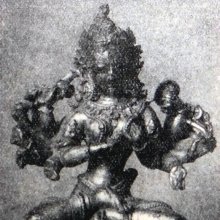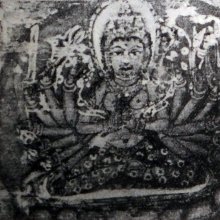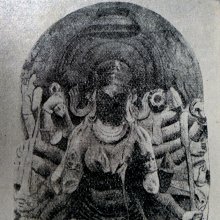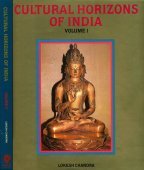Anima, Aṇimā: 15 definitions
Introduction:
Anima means something in Hinduism, Sanskrit, Jainism, Prakrit, Marathi, Hindi, Tamil. If you want to know the exact meaning, history, etymology or English translation of this term then check out the descriptions on this page. Add your comment or reference to a book if you want to contribute to this summary article.
Images (photo gallery)
In Hinduism
Yoga (school of philosophy)
Source: Wisdom Library: YogaAnima (अनिम) is a Sanskrit word referring to the “ability to become infinitely small like an atom”, as described in the Yoga Sūtras of Patañjali.
Source: ORA: Amanaska (king of all yogas): A Critical Edition and Annotated Translation by Jason BirchAṇimā (अणिमा) refers to “(the supernatural power of) minimization”, and as one of the “eight common Yogic paranormal powers”, represents one of the various signs and paranormal powers (siddhi) experienced by the Yoga practicioner, according to the Amanaska Yoga treatise.—The last fifty-two verses of the Amanaska’s first chapter describe a temporal sequence of psychosomatic signs and paranormal powers (siddhi) brought about by absorption (laya). In the Amanaska, The 8 common yogic paranormal powers are, [e.g., the power to be tiny (aṇimā)], [...] This list is similar to that given in Pātañjalayogaśāstra 3.45.

Yoga is originally considered a branch of Hindu philosophy (astika), but both ancient and modern Yoga combine the physical, mental and spiritual. Yoga teaches various physical techniques also known as āsanas (postures), used for various purposes (eg., meditation, contemplation, relaxation).
Purana and Itihasa (epic history)
Source: archive.org: Shiva Purana - English TranslationAṇimā (अणिमा) refers to the “power of minuteness”, representing the achievements of the eastern petal of the Aṣṭadala (mystical diagram of the lotus of eight petals), according to the Śivapurāṇa 2.1.11, while explaining the mode of worshipping Śiva:—“[...] the Liṅga shall be purified and installed with various mantras beginning with Praṇava and ending with Namaḥ (obeisance). The pedestal in the form of Svastika or lotus shall be assigned with Praṇava. In the eight petals, in the eight quarters, the eight achievements are identified [viz., the eastern petal is Aṇimā (minuteness)]”.
Source: Cologne Digital Sanskrit Dictionaries: The Purana Index1a) Aṇimā (अणिमा).—An aiśvarya, one of the eight kinds;1 the first to be attained by the yogin;2 leading to siddhi.3
- 1) Brahmāṇḍa-purāṇa I. 2. 39; II. 29. 82; III. 3. 65; 36. 17; 67. 16; Vāyu-purāṇa 2. 39.
- 2) Vāyu-purāṇa 13. 3 and 10.
- 3) Vāyu-purāṇa 57. 76; 92. 15.
1b) Siddhi devī on the 9th parvan of Cakrarājaratha; one of Uttama siddhis.*
- * Brahmāṇḍa-purāṇa IV. 19. 4; 25. 59; 35. 104; 36. 5; 44. 108.

The Purana (पुराण, purāṇas) refers to Sanskrit literature preserving ancient India’s vast cultural history, including historical legends, religious ceremonies, various arts and sciences. The eighteen mahapuranas total over 400,000 shlokas (metrical couplets) and date to at least several centuries BCE.
Vaishnavism (Vaishava dharma)
Source: Pure Bhakti: Bhagavad-gita (4th edition)Aṇimā (अणिमा) refers to “small like an atomic particle”. (cf. Glossary page from Śrīmad-Bhagavad-Gītā).
Source: Pure Bhakti: Bhajana-rahasya - 2nd EditionAṇimā (अणिमा) refers to:—The mystic perfection of being able to become small like a particle. (cf. Glossary page from Bhajana-Rahasya).
Source: Pure Bhakti: Brhad BhagavatamrtamAṇimā (अणिमा) refers to:—The mystic power of becoming infinitesimally small; as small as an atom. (cf. Glossary page from Śrī Bṛhad-bhāgavatāmṛta).

Vaishnava (वैष्णव, vaiṣṇava) or vaishnavism (vaiṣṇavism) represents a tradition of Hinduism worshipping Vishnu as the supreme Lord. Similar to the Shaktism and Shaivism traditions, Vaishnavism also developed as an individual movement, famous for its exposition of the dashavatara (‘ten avatars of Vishnu’).
Shaivism (Shaiva philosophy)
Source: Brill: Śaivism and the Tantric Traditions1) Aṇimā (अणिमा) refers to the “ability to make himself atomic”, according to the Guhyasūtra chapter 9.—Accordingly, “[...] [The Lord spoke]:—[...] He will be released from [the retributive force of] major transgressions; and he will attain low siddhis after two months, middling siddhis after half a year and high siddhis after a year; he will attain power over the spell. The ability to make himself atomic (aṇimā), along with the others [of the Yogic powers], will arise. He will take pleasure in the company of siddhas. He will attain the wishes he desires; if he is without desires, he will attain liberation. [...]”.
2) Aṇimā (अणिमा) refers to “becoming very small” and represents one of the eight supernatural natural powers, according to the Svacchandatantra verse 4.141-145.—Accordingly, “[...] The other form [of bubhukṣu initiation] is the lokadharmiṇī, which destroys both past and future demerit. That lokadharmiṇī-dīkṣā is known to exclude the obligation to propitiate mantras [by means of purvasevā etc.]. However, when the current body breaks, [the candidate] experiences [the series of eight supernatural natural powers] starting with becoming very small (aṇimā). Having experienced [these] enjoyments he moves upwards to whichever [cosmic level] the Guru has joined him [by yojanikā]. Whether this is at the sakala or niṣkala level [of Śiva] depends on [the preference of] the candidate and Guru”.

Shaiva (शैव, śaiva) or Shaivism (śaivism) represents a tradition of Hinduism worshiping Shiva as the supreme being. Closely related to Shaktism, Shaiva literature includes a range of scriptures, including Tantras, while the root of this tradition may be traced back to the ancient Vedas.
In Jainism
General definition (in Jainism)
Source: archive.org: TrisastisalakapurusacaritraAṇimā (अणिमा) is the name of a vidyā subdued by Rāvaṇa, according to the Jain Ramayana and chapter 7.1 [origin of the rākṣasavaṃśa and vānaravaṃśa] of Hemacandra’s 11th century Triṣaṣṭiśalākāpuruṣacaritra: an ancient Sanskrit epic poem narrating the history and legends of sixty-three illustrious persons in Jainism.
Accordingly, “[...] Rāvaṇa, knowing the highest good, not considering it worthless, remained motionless like a high mountain, absorbed in preeminent meditation. ‘Well done! Well done!’ was the cry of gods in the sky, and the Yakṣa-servants departed quickly, terrified. One thousand vidyās, the sky being lighted up by them, came to Daśāsya (=Rāvaṇa), saying aloud, ‘We are subject to you.’ [e.g., Aṇimā, ...] great vidyās beginning with these were subdued by noble Daśāsya in just a few days because of his former good acts. [...]”.
Source: Encyclopedia of Jainism: Tattvartha Sutra 3: The Lower and middle worldsAṇimā (अणिमा) refers to “transforming the body into smaller stature” and represents one of the eleven types of extraordinary form-changing (vikriyā), which itself is a subclass of the eight ṛddhis (extraordinary powers). These powers can be obtained by the Ārya (civilized people) in order to produce worldly miracles. The Āryas represent one of the two classes of human beings according to the 2nd-century Tattvārthasūtra 3.46, the other being Mleccha (barbarians).
What is meant by extraordinary power to transform into smaller stature (aṇimā-riddhi)? It is the extraordinary power by which one can transform his body into smaller stature.

Jainism is an Indian religion of Dharma whose doctrine revolves around harmlessness (ahimsa) towards every living being. The two major branches (Digambara and Svetambara) of Jainism stimulate self-control (or, shramana, ‘self-reliance’) and spiritual development through a path of peace for the soul to progess to the ultimate goal.
Languages of India and abroad
Marathi-English dictionary
Source: DDSA: The Molesworth Marathi and English Dictionaryaṇimā (अणिमा).—m S Subtilty, infinite minuteness, moleculism. 2 The first of the eight siddhi,--the subtil and invisible state assumable by a deity; the reduction of one's form to an aṇu or atom.
Source: DDSA: The Aryabhusan school dictionary, Marathi-Englishaṇimā (अणिमा).—f Minuteness. Atomic nature.
Marathi is an Indo-European language having over 70 million native speakers people in (predominantly) Maharashtra India. Marathi, like many other Indo-Aryan languages, evolved from early forms of Prakrit, which itself is a subset of Sanskrit, one of the most ancient languages of the world.
Hindi dictionary
Source: DDSA: A practical Hindi-English dictionaryAṇimā (अणिमा):—(nf) atomism; infinitesimal; the first of the eight siddhis (see) which imparts the capacity to assume infinitesimal form; ~[dika] the (eight) siddhis [aṇimā], etc.
...
Prakrit-English dictionary
Source: DDSA: Paia-sadda-mahannavo; a comprehensive Prakrit Hindi dictionaryAṇimā (अणिमा) in the Prakrit language is related to the Sanskrit word: Aṇiman.
Prakrit is an ancient language closely associated with both Pali and Sanskrit. Jain literature is often composed in this language or sub-dialects, such as the Agamas and their commentaries which are written in Ardhamagadhi and Maharashtri Prakrit. The earliest extant texts can be dated to as early as the 4th century BCE although core portions might be older.
Tamil dictionary
Source: DDSA: University of Madras: Tamil LexiconAṇimā (அணிமா) noun < aṇimā. Supernatural power of becoming as small as an atom, atomization, one of aṣṭa-mā-citti, q.v.; அஷ்டமா சித்தியுள் ஒன்றாகிய அணுப்போலாகை. [ashdama sithiyul onragiya anuppolagai.]
Tamil is an ancient language of India from the Dravidian family spoken by roughly 250 million people mainly in southern India and Sri Lanka.
See also (Relevant definitions)
Starts with (+7): Animadu, Animai, Animaka, Animakoa, Animal, Animal disease, Animal hide, Animal life, Animal sacrifice, Animalar, Animalarttiruppi, Animamtrita, Animan, Animana, Animandavya, Animani, Animanike, Animant, Animantaviyan, Animantrit.
Ends with: Akritidhvanima, Atanima, Chanima, Danima, Dhvanima, Ganima, Jamanima, Janima, Kanima, Lavanima, Mahanima, Manima, Sanima, Svanima, Upadhvanima, Vanima, Vutthanima.
Full-text (+52): Ashtasiddhi, Animan, Siddhi, Hierba de las animas, Amurtta, Aishvarya, Ashta-macitti, Animus, Ashtamahasiddhaya, Ashtsiddhi, Animasiddhi, Vishvatma, Pashupatayoga, Atman, Kayacitti, Devasthana, Caturdashahan, Caturdasha, Anutva, Smallness.
Relevant text
Search found 65 books and stories containing Anima, Aṇimā, Animaa; (plurals include: Animas, Aṇimās, Animaas). You can also click to the full overview containing English textual excerpts. Below are direct links for the most relevant articles:
Chaitanya Bhagavata (by Bhumipati Dāsa)
Verse 2.9.189 < [Chapter 9 - The Lord’s Twenty-One Hour Ecstasy and Descriptions of Śrīdhara and Other Devotees’ Characteristics]
Verse 1.8.180 < [Chapter 8 - The Disappearance of Jagannātha Miśra]
Verse 2.9.241 < [Chapter 9 - The Lord’s Twenty-One Hour Ecstasy and Descriptions of Śrīdhara and Other Devotees’ Characteristics]
Contribution of Vachaspati-Mishra to Samkhya System (by Sasikumar. B)
Mandukya Upanishad (Gaudapa Karika and Shankara Bhashya) (by Swami Nikhilananda)
Mandukya Karika, verse 4.9 < [Chapter IV - Alatashanti Prakarana (Quenching the firebrand)]
Brihad Bhagavatamrita (commentary) (by Śrī Śrīmad Bhaktivedānta Nārāyana Gosvāmī Mahārāja)
Verse 2.3.26 < [Chapter 3 - Bhajana (loving service)]
Verse 2.2.81 < [Chapter 2 - Jñāna (knowledge)]
Verse 2.3.29 < [Chapter 3 - Bhajana (loving service)]
Yoga-sutras (with Vyasa and Vachaspati Mishra) (by Rama Prasada)
Sūtra 3.44 < [Book 3 - Attainment (Vibhūti or Siddhi)]
Sūtra 1.8 < [Book 1 - Trance (Samādhi)]
Sūtra 2.43 < [Book 2 - Practice (Sādhana)]
The Padma Purana (by N.A. Deshpande)
Chapter 166 - Pāṇḍurāryā-tīrtha < [Section 6 - Uttara-Khaṇḍa (Concluding Section)]
Chapter 74 - Arjuna’s Wish and Its Fulfilment < [Section 5 - Pātāla-Khaṇḍa (Section on the Nether World)]
Chapter 127 - The Release of a Demon < [Section 6 - Uttara-Khaṇḍa (Concluding Section)]
Related products





